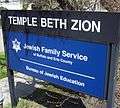Temple Beth Zion (Buffalo, New York)
| Temple Beth Zion | |
|---|---|
 | |
| Basic information | |
| Location |
805 Delaware Avenue, Buffalo, New York, United States |
| Geographic coordinates | 42°54′23″N 78°52′18″W / 42.9063442°N 78.8717827°WCoordinates: 42°54′23″N 78°52′18″W / 42.9063442°N 78.8717827°W |
| Affiliation | Reform Judaism |
| Ecclesiastical or organizational status | Sanctuary |
| Status | Active |
| Leadership | Senior Rabbi: Gary Pokras Assistant Rabbi: Laurie Green |
| Website |
www |
| Architectural description | |
| Architect(s) | Max Abramovitz |
| Architectural style | Modern |
| Groundbreaking | June 21, 1964 |
| Completed | 1966-1967 |
| Specifications | |
| Capacity | 1,000 |
| Height (max) | 62 feet (18.9 m) |
| Materials | Alabama limestone |
Temple Beth Zion is a Reform synagogue located at 805 Delaware Avenue in Buffalo, New York. Founded in 1850, Temple Beth Zion is the largest Jewish congregation in Western New York and one of the oldest and largest Reform congregations in the nation. The circular building features 10 scallop walls, each a symbol of the 10 commandments. [1] The temple contains a Casavant Frères 48-rank, 4000-pipe organ.
The Benjamin and Dr. Edgar R. Cofeld Judaic Museum, open during regular hours, features a rotating collection of Judaica.[2]
Previous buildings
.jpg)
Before building their current home, the congregation worshiped in two previous buildings. The first building was the old Niagara Street Methodist Church (between Pearl Street and Franklin Street). The church was renovated, rededicated, and used as the home of Temple Beth Zion until 1886. The second building was a Byzantine-styled, copper-domed temple built in 1890, and located at 599 Delaware Avenue (now Buffalo Clinical Research Center). That building was destroyed in a fire in 1961. [3]
Gallery
References
- ↑ Garner, Robyn (2006). "Temple Beth Zion Building Facilities". Temple Beth Zion. Retrieved 2011-05-12.
- ↑ "TBZ Places & Spaces". Temple Beth Zion. Retrieved 26 January 2016.
- ↑ LaChiusa, Chuck (2003). "Temple Beth Zion - History". Buffalo as History. Retrieved 2011-05-12.

